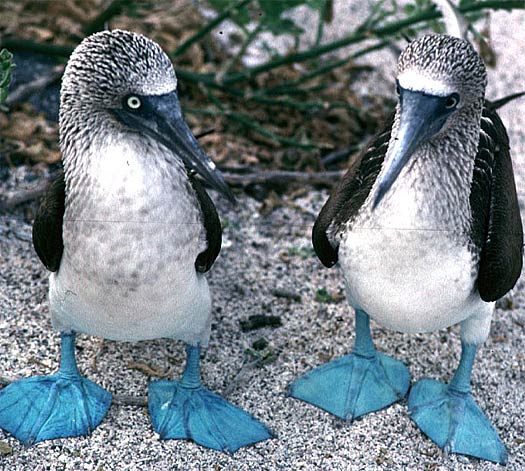Since my previous entry was on blue-plate specials, I thought I'd continue the blue theme. I wanted to talk about something unusual as well as blue, and what's more unusual than blue-footed boobies?

Two blue-footed boobies. Looks like they're having a conversation. "What's up, Deb?" "Not much, Fred."
(Photo from NatureWorks)

The first and most essential part of the mating dance: the male picks up his feet one at a time and shows them off. He returns to this move several times throughout the dance, almost like a refrain.
(Photo from PR Log)
Below is a link to a sort of art-haus version, showing the dance taking place among several different pairs of boobies and with lots of close-ups. There are also a few shots of the boobies flying, which is very graceful, followed by landings, which are not. The video ends in the ultimate success for one pair: copulation. Afterward, the male looks very proud of himself.


Blue-footed booby going into a dive. So streamlined and perfectly angular, it almost looks mechanical, doesn't it?
(Photo by Rob Kroenert at Endless Loop)

Photographer Tony Mills put a sequence of photos of a booby diving to create this image, showing the bird's arrow-like entry into the water.
(You can purchase a signed, limited edition print of this image for £85 from Tony Mills' Action in Nature)

The range of the blue-footed booby
(Map from National Geographic)

The Galápagos Islands is a cluster of about 14 islands off the western-most knob of South America. The islands were once upon a time the haven of pirates, as well as the home of unusual animals like the blue-footed booby.
(Map from worldatlas.com)
Sources
National Geographic.com, Blue-Footed Booby, "Extinct" Booby Exposed -- Found "Masked," Using Alias, August 11, 2009
Cornell Lab of Ornithology, All About Birds, Blue-footed Booby
MarineBio.org, Blue-footed Boobies, Sula nebouxii
FactZoo.com, Blue-footed Booby - Blue Feet, Deep Diver

Two blue-footed boobies. Looks like they're having a conversation. "What's up, Deb?" "Not much, Fred."
(Photo from NatureWorks)
- The blue-footed boobies (Sula nebouxii) have magnificently odd feet -- very large and also blue. The male birds show off their big blue feet to the females with a series of high-stepping struts. The bigger and bluer the feet, the better the ladies like them.

The first and most essential part of the mating dance: the male picks up his feet one at a time and shows them off. He returns to this move several times throughout the dance, almost like a refrain.
(Photo from PR Log)
- The reason the males show off their feet so much is not because foot size corresponds with the size of another male feature, but rather because their feet are important to the survival of their offspring. The blue-footed booby does not sit but rather stands on its eggs. The bigger their feet, the better able they are to keep the eggs warm, and the more viable the hatchling.
- Granted, it's the female who does most of the standing while the male goes off to collect food. But sometimes the male stands on the eggs too while she's out fishing. And if she finds a male with big feet, her offspring are more likely to have big feet, which means their eggs will do better, and so on down the line.
- Males and females look very much alike. The female is slightly larger, and the male has a slightly bigger tail.
- Their calls are more distinct. The male makes and whispery whishing noise.The female makes a kind of grunting barking sound.
- Now that you'll be able to tell who's who in the mating videos, here's how the mating dance goes:
- The male picks up and puts down his big flue feet, showing them off.
- He dips his chest and flares his wings and slows off his feet some more.
- Then he presents the female with twigs and other nest materials -- which is a bit strange since they don't actually build nests
- The two both participate in a courtship flight (though this doesn't happen in a lot of videos I've seen)
- The male shows off his feet again
- The female joins in, picking up and putting down her feet too.
- They both do the chest dip and wing flare, pointing their beaks skyward. He makes his whispery whishing sound and she makes her louder groaning sound.
- Mating happens.
Below is a link to a sort of art-haus version, showing the dance taking place among several different pairs of boobies and with lots of close-ups. There are also a few shots of the boobies flying, which is very graceful, followed by landings, which are not. The video ends in the ultimate success for one pair: copulation. Afterward, the male looks very proud of himself.

- Boobies are monogamous. Which means that once the female is interested enough to do the full dance with him, the two of them will be dancing like that together until the last disco ball light goes out.
- They don't have a particular breeding season. One site put it that they are "opportunistic breeders." Which means that when it feels right, they go for it.
- Other things about the blue-footed booby's nesting habits are kind of disgusting. They don't build a nest but lay their eggs on the bare ground. While the birds are roosting on the nest, they crap all over the place, and the eggs become surrounded by a dried wall of booby excrement.
- Their big feet may make them ungainly on land -- which is what apparently led Europeans to give them a name which means "stupid" or "clown" or I think this may be the best translation: "goofball" -- but they are anything but in the air.
- They are sea-going birds, flying out to sea in search of schools of fish. When they spot some tasty fish, sometimes from as high as 330 feet up, they fold back their wings to become streamlined as an arrow and dive into the water to spear the unsuspecting fish.

Blue-footed booby going into a dive. So streamlined and perfectly angular, it almost looks mechanical, doesn't it?
(Photo by Rob Kroenert at Endless Loop)

Photographer Tony Mills put a sequence of photos of a booby diving to create this image, showing the bird's arrow-like entry into the water.
(You can purchase a signed, limited edition print of this image for £85 from Tony Mills' Action in Nature)
- They hit the water at speeds up to 60 miles per hour.
- To the envy of many an Olympic diver, though they plunge from enormous heights, they make almost no splash.
- They especially like to eat anchovies and flying fish. Sometimes they can snag a flying fish from out of the air.
- While each booby is so individually gifted, they hunt in flocks. When one booby spots a school of fish, it will call to the others, and they will all swarm over and each go into their stupendous dives, each one spearing a fish.
- They can also dive down to get fish while bobbing on the water's surface. This is true of only the blue-footeds. Other boobies can't do this.
- The blue-footeds live along the western coasts of Central and South America. About half of all blue-footeds live on the Galápagos Islands.

The range of the blue-footed booby
(Map from National Geographic)

The Galápagos Islands is a cluster of about 14 islands off the western-most knob of South America. The islands were once upon a time the haven of pirates, as well as the home of unusual animals like the blue-footed booby.
(Map from worldatlas.com)
- Every once in a great while they may venture as far north as the coastlines of Texas, Arizona, or California. In California, they are fond of the Salton Sea.
- The other feature about them that earned them the name "stupid" is that they seem to have no fear of humans. You'd think this would have resulted in their extinction or near-extinction, but the flue-footeds are doing just fine. Though their colony on the Galápagos does have protected status.
- Actually, the blue-footed booby isn't all that unusual. There are five other species of booby. There is the red-footed (which made an appearance when the Brady Bunch went to Hawaii), the brown, the Peruvian, the Nazca, and the masked.
- That last species, the masked, was recently discovered to be the same as the Tasman, which had been thought to be extinct. Well, what did you expect from a bunch of boobies wearing masks, that people would know right off who they were?
Sources
National Geographic.com, Blue-Footed Booby, "Extinct" Booby Exposed -- Found "Masked," Using Alias, August 11, 2009
Cornell Lab of Ornithology, All About Birds, Blue-footed Booby
MarineBio.org, Blue-footed Boobies, Sula nebouxii
FactZoo.com, Blue-footed Booby - Blue Feet, Deep Diver
No comments:
Post a Comment
If you're a spammer, there's no point posting a comment. It will automatically get filtered out or deleted. Comments from real people, however, are always very welcome!